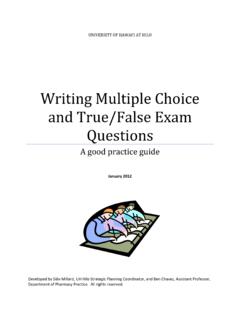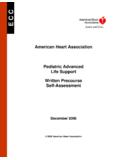Transcription of The Method Chapter - SAGE Publications Inc
1 5 The Method ChapterDescribing Your Research PlanThe Method Chapter of a dissertation, article, or proposal describesthe exact steps that will be undertaken to address your hypotheses orresearch questions. For this reason, the Method section follows logicallyfrom the statement of the problem in much the same way as researchquestions follow from the Review of the Literature. The goal of thischapter is to provide a clear and complete description of the specific stepsto be followed. It is necessary to describe these steps in sufficient detailto help a na ve reader to replicate your Chapter 3, we suggested that students select a suitable problembefore selecting the appropriate Method with which to study that some dissertations, however, the Method may in fact be the topic ofstudy.
2 A student may become excited about the possibilities of a particulardata collection technique or Method prior to generating a suitable prob-lem. In most cases, though, the appropriate Method of study is generatedby careful consideration of the research questions and the applicablemethod by which those questions may be studied. The following materialis divided into two major sections, one that focuses primarily on the quan-titative dissertation and one that focuses on the qualitative dissertation; westrongly recommend that you read both sections. The issues to be consid-ered are not independent of each other, and there is considerable overlapin the content of this Chapter , regardless of the Method being 2/26/2007 5:24 PM Page 87 The Method Chapter in a Quantitative DissertationThe Method Chapter is the place in which the exact steps you will befollowing to test your questions are enumerated.
3 The Method chaptertypically contains the following three subsections: Subjects or Participants,Instrumentation or Measures, and Procedures. In addition, the Methodchapter of a dissertation proposal often contains a Statistical Analysis orData Analysis section, in which procedures for approaching the data areoutlined. Research that uses special equipment frequently contains anApparatus section, in which the nature and type of equipment are frequent mistake contained in first drafts of Method chaptersinvolves overuse of the opportunity to rehash the material contained inthe Review of the Literature or Statement of the Problem, which werepresented in another Chapter .
4 The Method Chapter should be viewed pri-marily as a set of directions for conducting a specific piece of research. Wefollow this perspective in describing each of the subsections of a to Begin a Method ChapterA reasonable way to begin a Method Chapter is to develop an introductoryparagraph that describes both the design of the study and the organizationof the Chapter . This prepares the reader for what is to follow andprovides a framework within which to incorporate the materials. This para-graph says to the reader, This is the Method Chapter , this is how itis organized, and this is the type of design I used.
5 The most difficultcomponent of the introductory paragraph may appear to be the design state-ment. There are dozens of books that take research design as their sole purpose here is not to review this extensive material. In this context, weare suggesting only a short sentence or two that informs the reader of thegeneral type of design and any suitable label that may be applied to example, imagine a study in which you plan to mail 700 surveysto retired male executives in an attempt to assess their adjustment toretirement. It is probably sufficient simply to state something like thefollowing: This study used a cross-sectional survey design to assessadjustment to retirement of a sample of retired male executives.
6 Similarly, imagine an experimental design in which two dichotomousvariables will be used as independent variables. It may be sufficient todescribe the design as an experimental study using a 2 2 factorial88 WORKING WITH THE 2/26/2007 5:24 PM Page 88design. An example of such a design is described in a dissertation bySangster (1991):An experimental, 2 2 factorial, pretest -posttest design was used to testthe hypothesis. The independent variables were (a) training type and(b) management experience. Respective levels of independent variableswere descriptive and prescriptive training, and high and low managementexperience.
7 (p. 102)Determining exactly which type of design description best fits yourstudy can be accomplished by referencing one of the many texts thatdescribe designs ( , Campbell & Stanley, 2005; Kerlinger & Lee, 1999),but a specific label may not be as important as a clear explanation of thestructure of your study. For example, a dissertation by Macdonald (1990)examined the relationships among empathy, personal maturity, andemotional articulation. Macdonald described her design as follows: The research design was a correlational design utilizing cross-sectionalsurvey methodology and includes a number of survey instruments.
8 The pur-pose of the design was to correlate the scores of the personality tests listedbelow with the scores on responses to the short stories, as well as measurethe interrelationship of the responses to the short stories. (p. 115)Describing Your SampleThe Subjects (or Participants) section of the Method Chapter describes thesource and number of subjects you will be using (in a proposal) or thesource and number of subjects actually obtained (in a completed project).Note that we use the term subjectsin a very broad context. The subjects maybe informants or participants in the research, organizations or events, docu-ments or segments of commercials edited from television programs, oreven an entire society, as in the case of anthropological research.
9 In studiesof human beings, the term participantsis generally preferable to the termsubjects. One goal of this section of the Method Chapter is to describe whyand how the particular unit of analysis was frequent problem we have observed is that students often confounda description of the sampling of subjects with the procedures used tocollect data from these subjects. The former belongs in the Subjectssection, whereas the latter belongs in the Procedures section. Of particularimportance in the Subjects section are the specific sampling proceduresThe Method Chapter 2/26/2007 5:24 PM Page 89used, the rationale for selecting a given number of subjects, and the sourceof the subjects.
10 Which type of sample will you draw: random, stratified,purposive? Where will your subjects be located? How many subjects arenecessary for your particular design? Each of these questions is importantand should be dealt with in the Subjects section. We discuss each in turn inthis Sampling is the case with research design in general, theissue of sampling is a complex one. Our purpose, however, and your pur-pose as researcher, is not to discuss the knotty problems of sampling. Yourjob is to describe how you will accomplish this task in your study, takingall the theoretical and practical issues into account.












